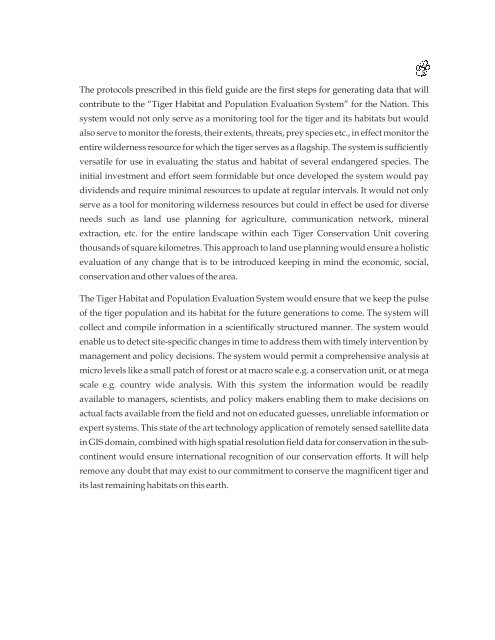FIELD GUIDE Monitoring Tigers, Co-Predators, Prey and their Habitats
FIELD GUIDE Monitoring Tigers, Co-Predators, Prey and their Habitats
FIELD GUIDE Monitoring Tigers, Co-Predators, Prey and their Habitats
You also want an ePaper? Increase the reach of your titles
YUMPU automatically turns print PDFs into web optimized ePapers that Google loves.
The protocols prescribed in this field guide are the first steps for generating data that will<br />
contribute to the “Tiger Habitat <strong>and</strong> Population Evaluation System” for the Nation. This<br />
system would not only serve as a monitoring tool for the tiger <strong>and</strong> its habitats but would<br />
also serve to monitor the forests, <strong>their</strong> extents, threats, prey species etc., in effect monitor the<br />
entire wilderness resource for which the tiger serves as a flagship. The system is sufficiently<br />
versatile for use in evaluating the status <strong>and</strong> habitat of several endangered species. The<br />
initial investment <strong>and</strong> effort seem formidable but once developed the system would pay<br />
dividends <strong>and</strong> require minimal resources to update at regular intervals. It would not only<br />
serve as a tool for monitoring wilderness resources but could in effect be used for diverse<br />
needs such as l<strong>and</strong> use planning for agriculture, communication network, mineral<br />
extraction, etc. for the entire l<strong>and</strong>scape within each Tiger <strong>Co</strong>nservation Unit covering<br />
thous<strong>and</strong>s of square kilometres. This approach to l<strong>and</strong> use planning would ensure a holistic<br />
evaluation of any change that is to be introduced keeping in mind the economic, social,<br />
conservation <strong>and</strong> other values of the area.<br />
The Tiger Habitat <strong>and</strong> Population Evaluation System would ensure that we keep the pulse<br />
of the tiger population <strong>and</strong> its habitat for the future generations to come. The system will<br />
collect <strong>and</strong> compile information in a scientifically structured manner. The system would<br />
enable us to detect site-specific changes in time to address them with timely intervention by<br />
management <strong>and</strong> policy decisions. The system would permit a comprehensive analysis at<br />
micro levels like a small patch of forest or at macro scale e.g. a conservation unit, or at mega<br />
scale e.g. country wide analysis. With this system the information would be readily<br />
available to managers, scientists, <strong>and</strong> policy makers enabling them to make decisions on<br />
actual facts available from the field <strong>and</strong> not on educated guesses, unreliable information or<br />
expert systems. This state of the art technology application of remotely sensed satellite data<br />
in GIS domain, combined with high spatial resolution field data for conservation in the subcontinent<br />
would ensure international recognition of our conservation efforts. It will help<br />
remove any doubt that may exist to our commitment to conserve the magnificent tiger <strong>and</strong><br />
its last remaining habitats on this earth.<br />
5

















